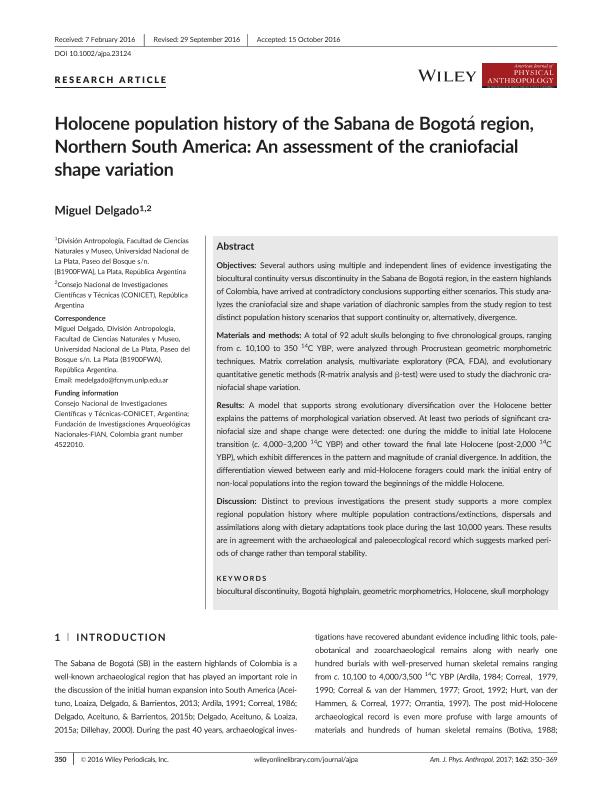Artículo
Holocene population history of the Sabana de Bogotá region, Northern South America: An assessment of the craniofacial shape variation
Fecha de publicación:
02/2017
Editorial:
Wiley-liss, Div John Wiley & Sons Inc
Revista:
American Journal Of Physical Anthropology
ISSN:
0002-9483
Idioma:
Inglés
Tipo de recurso:
Artículo publicado
Clasificación temática:
Resumen
Objectives: Several authors using multiple and independent lines of evidence investigating the biocultural continuity versus discontinuity in the Sabana de Bogotá region, in the eastern highlands of Colombia, have arrived at contradictory conclusions supporting either scenarios. This study analyzes the craniofacial size and shape variation of diachronic samples from the study region to test distinct population history scenarios that support continuity or, alternatively, divergence. Materials and methods: A total of 92 adult skulls belonging to five chronological groups, ranging from c. 10,100 to 350 14C YBP, were analyzed through Procrustean geometric morphometric techniques. Matrix correlation analysis, multivariate exploratory (PCA, FDA), and evolutionary quantitative genetic methods (R-matrix analysis and β-test) were used to study the diachronic craniofacial shape variation. Results: A model that supports strong evolutionary diversification over the Holocene better explains the patterns of morphological variation observed. At least two periods of significant craniofacial size and shape change were detected: one during the middle to initial late Holocene transition (c. 4,000–3,200 14C YBP) and other toward the final late Holocene (post-2,000 14C YBP), which exhibit differences in the pattern and magnitude of cranial divergence. In addition, the differentiation viewed between early and mid-Holocene foragers could mark the initial entry of non-local populations into the region toward the beginnings of the middle Holocene. Discussion: Distinct to previous investigations the present study supports a more complex regional population history where multiple population contractions/extinctions, dispersals and assimilations along with dietary adaptations took place during the last 10,000 years. These results are in agreement with the archaeological and paleoecological record which suggests marked periods of change rather than temporal stability.
Archivos asociados
Licencia
Identificadores
Colecciones
Articulos(CCT - LA PLATA)
Articulos de CTRO.CIENTIFICO TECNOL.CONICET - LA PLATA
Articulos de CTRO.CIENTIFICO TECNOL.CONICET - LA PLATA
Citación
Delgado Burbano, Miguel Eduardo; Holocene population history of the Sabana de Bogotá region, Northern South America: An assessment of the craniofacial shape variation; Wiley-liss, Div John Wiley & Sons Inc; American Journal Of Physical Anthropology; 162; 2; 2-2017; 350-369
Compartir
Altmétricas




